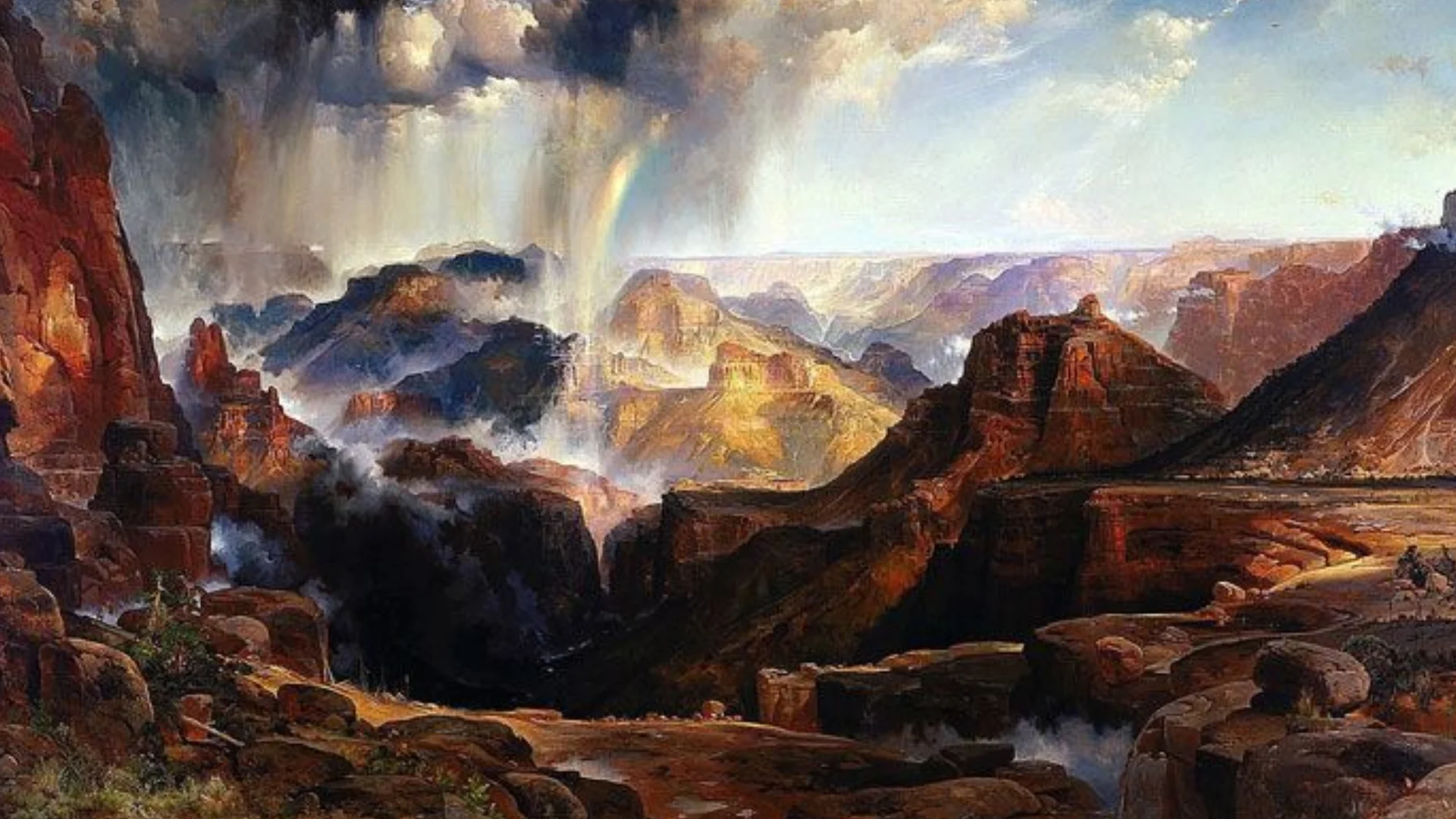Thomas Moran, a pivotal figure in American art, is renowned for his breathtaking landscapes that brought the grandeur of the American West to the public’s imagination. Born in 1837 in Bolton, England, Moran emigrated to the United States with his family at a young age. His artistic journey began in Philadelphia, where he apprenticed as a wood engraver before transitioning to painting. Today, Thomas Moran’s paintings are celebrated for their vibrant color, intricate detail, and the awe-inspiring beauty they depict.
The Beginnings of an Artistic Legacy
Moran’s early work was heavily influenced by the Hudson River School, a mid-19th-century American art movement known for its romantic portrayal of nature. Under the mentorship of his older brother, Edward Moran, also a noted artist, Thomas honed his skills in drawing and painting. His fascination with landscapes was evident from the start, but it was his later explorations that truly set his work apart.
Journey to the American West
In 1871, Moran’s career took a defining turn when he joined the Hayden Geological Survey of 1871, led by Ferdinand V. Hayden. This expedition to Yellowstone, the first federally funded survey of the region, was a transformative experience for Moran. His paintings from this journey, including the iconic “The Grand Canyon of Yellowstone,” played a crucial role in the establishment of Yellowstone as the first National Park in 1872.
Thomas Moran’s paintings from this period are characterized by their dramatic use of light and shadow, vivid colors, and meticulous attention to detail. His ability to capture the raw beauty and untamed nature of the American West captivated audiences and significantly contributed to the national appreciation of these landscapes.
Artistic Techniques and Style
Moran’s technique was a blend of realism and romanticism. He was known for his ability to render landscapes with photographic accuracy while infusing them with an ethereal, almost otherworldly quality. This duality in his work is what makes Thomas Moran’s paintings so compelling. His use of light to create depth and his bold, yet harmonious color palette were instrumental in conveying the majestic beauty of the scenes he depicted.
Moran often sketched in the field, capturing the essence of the landscape, and then completed his paintings in the studio. This method allowed him to combine firsthand observation with artistic interpretation, resulting in works that were both accurate and emotionally resonant.
Impact and Legacy
The impact of Thomas Moran’s paintings extends beyond the art world. His works played a pivotal role in the conservation movement in the United States. The visual documentation of the American West that Moran provided helped galvanize public and political support for the preservation of these natural wonders. His paintings were instrumental in the creation of not only Yellowstone National Park but also other parks and protected areas.
Moran’s influence can be seen in the work of later landscape artists and in the broader cultural appreciation for the natural beauty of the American West. His paintings continue to be celebrated for their artistic merit and their historical significance.
Notable Works
Some of the most famous Thomas Moran paintings include:
- “The Grand Canyon of the Yellowstone” (1872): This painting is perhaps Moran’s most iconic work. It captures the breathtaking view of Yellowstone’s canyon with dramatic light effects and rich, vibrant colors.
- “Mountain of the Holy Cross” (1875): This work depicts the distinctive cross-shaped snowfield on Colorado’s Mount of the Holy Cross. It became an emblematic image of the American West.
- “Chasm of the Colorado” (1873-1874): Another masterpiece, this painting portrays the grandeur of the Grand Canyon with remarkable detail and a striking composition.
- “Shoshone Falls on the Snake River” (1900): This later work showcases Moran’s continued fascination with the natural wonders of the American landscape, capturing the powerful beauty of Shoshone Falls in Idaho.
Personal Life and Later Years
Despite his travels and the acclaim he received, Moran remained grounded in his personal life. He married Mary Nimmo Moran, a talented landscape artist in her own right, and they had three children. The couple often traveled together, and Mary’s influence can be seen in some of Thomas’s works.
In his later years, Moran continued to paint, although his style evolved to incorporate softer tones and a more impressionistic approach. He remained active in the art community until his death in 1926, leaving behind a legacy that continues to inspire and captivate.
Conclusion
Thomas Moran’s paintings are more than just artistic representations of the American West; they are visual documents that have shaped the cultural and historical understanding of these landscapes. His unique ability to blend realism with romanticism created works that are both stunningly beautiful and deeply evocative. Through his art, Moran not only captured the majesty of the American wilderness but also played a crucial role in its preservation. The legacy of Thomas Moran’s paintings endures, inviting viewers to experience the awe-inspiring beauty of the natural world.
In exploring the vast and varied works of Thomas Moran, one cannot help but be transported to the wild and wonderful places he so masterfully depicted. His paintings remain a testament to the enduring power of nature and the timeless allure of the American landscape











